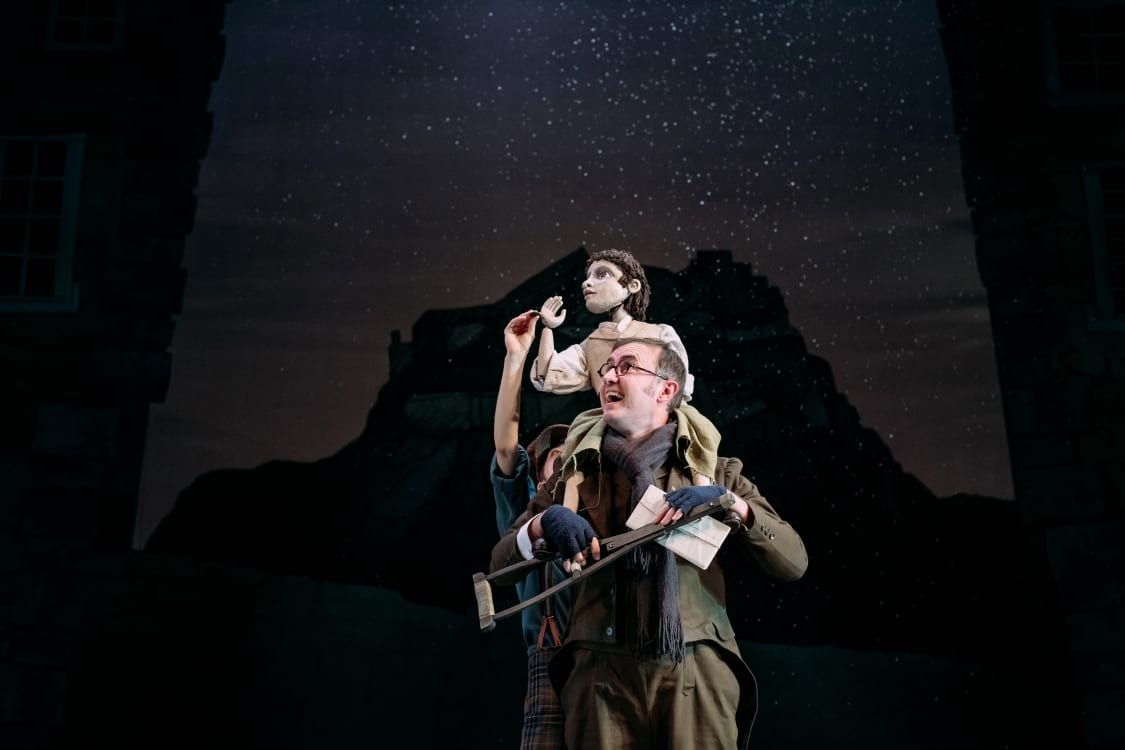Ebenezer Scrooge, the famous miser at the heart of Charles Dickens’ A Christmas Carol, was allegedly based on the headstone of one Ebenezer Scroggie, a “meal man” (misread as a “mean man” by Dickens) buried in Edinburgh’s Canongate Kirkyard. While the story probably has about as much truth in it as that of Greyfriars Bobby (more on him later), it provides more than enough justification for Tony Cownie to re-set A Christmas Carol, this year’s Lyceum Christmas play, in Edinburgh.
The story fares well from its relocation north. Cownie gets the most out of Scotland’s strict Presbyterian past, and Scottish terminology like “Rab” Cratchit and the ghost of “Nouadays” slot in seamlessly, raise a laugh or both. Anybody familiar with the travails of the Edinburgh Council or various Scottish banks in recent years will get a chuckle from some of the modernity-inflected jokes. Contrastingly, the dark and foggy closes of Edinburgh, conjured simply by theatre flats, are a natural fit with the gloomy pall Scrooge (Crawford Logan) casts over the early stages of the play.
Unfortunately, by comparison with the Lyceum’s usual Christmas excellence, An Edinburgh Christmas Carol suffers a little from conventional staging and an occasionally ponderous script. The action is rather flat and horizontal, and the scenes (and scene changes) can be laborious at times. Logan’s Scrooge is appropriately grouchy, and it’s not a character that requires any great nuance, but the play would benefit from a little more subtlety in tone on his part.
The rest of the ensemble cast provide solid support, with Nicola Roy in particular bringing considerable verve to her various characters. Her arch housekeeper, over-excitable Salvation Army collector and husband-weary wife lift the play every time they come on stage. Roy was also a lively presence in the excellent (and energetic) The Belle’s Stratagem (another Edinburgh-set re-telling directed by Cownie at the Lyceum), and in her characters we get a glimpse of the enjoyable romp An Edinburgh Christmas Carol could have been.
Another positive addition is the community choir. As well as delivering beautifully-sung renditions of seasonal carols, they get in on some of the stage business as well, giving Grant O’Rourke’s policeman an especially hard time.
More dynamism is brought to the staging through the puppets used to represent Tiny Tim and Greyfriars Bobby, the loyal Skye Terrier who has a starring role in the play. Simon Auton’s puppet of Tim highlights his small stature and fragility, and Edie Edmundson (a puppet director and performer) skillfully brings both him and Bobby to life.
The addition of Bobby to the story is a particularly effective one. It allows the character of Tim to share some of the emotional load, which in other tellings can risk overwhelming his slender shoulders with schmaltz. Bobby also brings some much-appreciated action, dashing about the stage stealing sausages and terrorising the long-suffering policeman.
Bobby, and some lively pantomime touches, ensure that younger audiences will largely be entertained. They will laugh at the fart jokes, be unnerved by the ghost of Ayont (Christmas Yet to Come) and gasp at one or two moments of nifty stage magic. There might not be enough energy or emotional heft for An Edinburgh Christmas Carol to be as fully engaging as previous Lyceum Christmas shows, but it still makes for a festive night out.

